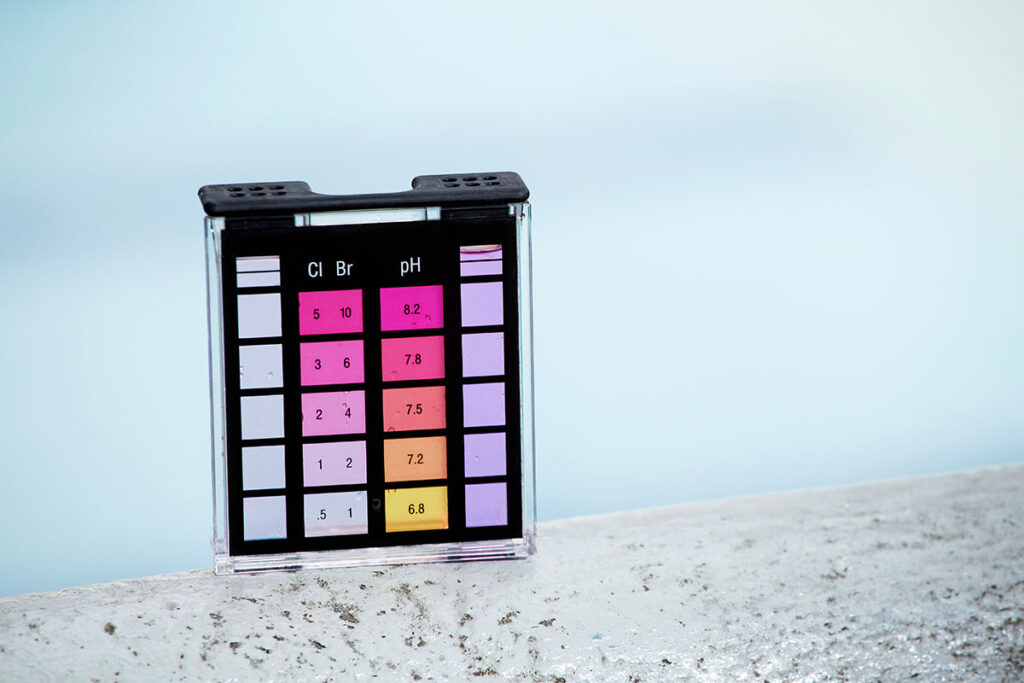Pool owners understand the critical need to keep their swimming pool water balanced. It is not only important for water quality but also for general human and animal health. This typically entails maintaining pH levels and effective chlorine levels. Total alkalinity is another crucial element in keeping your pool water safe and balanced, as it measures the capacity of the water’s buffer system to withstand pH shifts.

The Measure of pH Explained
Chemistry defines pH as the measure of how acidic or basic a solution is. A more acidic solution has more free hydrogen ions, while one that has more basic characteristics has more free hydroxide ions. It is essential to comprehend the distinction between acid and base, as your body regulates its pH balance to keep you healthy. A test of your blood pH may be conducted as part of a doctor’s visit or if you have a health condition requiring monitoring.
The pH scale is logarithmic, meaning that an increase or decrease of one digit will alter the concentration of hydrogen ions tenfold. So while pH 7 is neutral and pH 14 highly acidic, an increase or decrease of one digit will drastically change conditions.
The value of pH can be measured using meters or other instruments specifically designed for this task. Colored strips of paper, such as red and blue litmus, may also be employed to indicate pH levels.
The balance of pH levels and total alkalinity in swimming pool water is critical for safety and proper maintenance. Having the appropriate amount of alkalinity keeps your waters clear and safe to swim in while also helping prevent dryness or cracking on skin surfaces.
Total alkalinity is a measure of how much alkaline substance is in the water.
The pH scale is a logarithmic measure of the concentration of hydrogen ions in a solution, ranging from 0 to 14. Lower pH indicates acidity and higher pH indicates alkalinity; pure water has a pH value of 7 and is considered perfectly neutral.
In pure water, a few hydrogen molecules from their H2O structure dissociate through dissociation. This causes them to form hydrogen ions (H+) and hydroxyl ions (OH-).
Acidification of water can result in a drastic shift in its pH level. Typically, this occurs from rain or snowfall; however, soil sources may also contribute to this change depending on where it occurs.
Eventually, acids are neutralized by compounds found naturally in water, such as bicarbonates. This property of water is known as its buffering capacity.
Total alkalinity can be measured by adding small amounts of acid to water and checking its pH as the acid is added. This method is commonly employed by the U.S. Geological Survey; they take an initial reading of the water, add small amounts in increments, stir it thoroughly, and check its pH again. This process is repeated several times for accuracy.
The relationship between pH levels and total alkalinity is important in swimming pool safety and maintenance.
Swimming pool safety and maintenance require maintaining proper pH levels and total alkalinity. Excessive high or low of either can disrupt water chemistry, interfere with chlorine’s ability to disinfect, and damage pool equipment. It is critical that you are aware of these factors.
The ideal pH for a pool is slightly basic (7.2-7.4), close to the body’s natural pH level. When your pool’s pH drops below this ideal range, it can damage its liner, plaster, and other components; stain metal equipment; irritate patrons’ eyes, skin, and mucous membranes; all at risk.
Low pH levels in pools often result from using chlorinated tablets or stabilized form chlorine, excessive rainfall, heavy leaf debris in the pool, and dirt/mulch buildup. To correct this situation, you will need a pH Reducer such as Dry Acid or Muriatic Acid these can also work as a Total Alkalinity Decreaser.
It is best to make small adjustments over several days. A sudden plunge in alkalinity could drastically lower the pool’s pH, potentially leading to corrosion of its surface and equipment. Once pH and total alkalinity have been restored, you can use pH Increaser or another acid to raise both of these factors simultaneously.
Keeping the levels balanced between pH and the total alkalinity is more important than one might think. If you get it wrong, damage or injury could occur. As a responsible commercial pool or homeowner, it is crucial that you keep your eye on these readings.